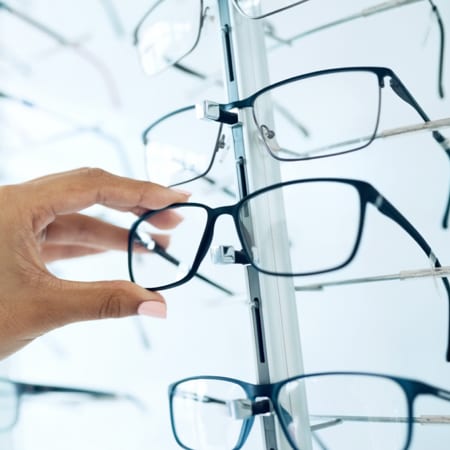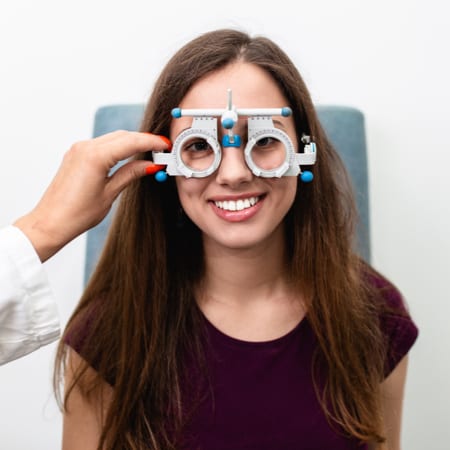Focusing on Vibrant Vision
At Woodstock Vision Care, we understand the importance of healthy, long-term vision for your children. Visual challenges can impact various aspects of their lives, including academic performance. While school screenings are common, they may not capture the full picture of your child’s vision needs.
Our comprehensive eye exams aim to see that your child’s visual development is monitored, detecting any unnoticed vision problems and helping them see optimally. Book your child’s eye exam with us today.

Recognizing Signs of Vision Problems
Children may not always express vision concerns verbally. Look out for signs such as frequent squinting, rubbing of eyes, or sitting close to the TV.
If you observe any potential signs of vision issues, don’t hesitate to schedule an appointment with us. Your vigilance today can positively impact your child’s vision tomorrow.


What to Expect During Your Child’s Eye Test
It’s common for children to be nervous before an eye exam, so our first priority is always to help them feel at ease. Sometimes it’s showing off fancy machinery, for others a soft description of what the exam involves.
Our doctors have a knack for helping kids relax and enjoy their exams, so we always start with a quick meet and greet before proceeding through the following.
During your child’s eye exam, we focus on assessing various aspects, including:
- Visual Acuity: clear vision at different distances
- Eye Focusing: maintaining clarity during changes in focus and distance
- Eye Tracking: keeping eyes on target when shifting focus
- Eye Teaming: using both eyes together for depth perception
- Hand-Eye Coordination: processing visual information and directing hands accordingly
- Visual Perception: the brain’s ability to make sense of what they eyes see
- An overall health assessment of your child’s eyes
Myopia Control at Woodstock Vision Care
Myopia, or nearsightedness, can affect your child’s distance vision from a young age. Unaddressed, it can impact both academic and recreational activities. At Woodstock Vision Care, we offer comprehensive myopia control methods, including Zeiss Myocare lenses, atropine eye drops, Abiliti 1-Day contacts, and more.
What to Expect During Your Child’s Eye Exam
During your child’s eye exam, we focus on assessing various aspects, including:
- Visual Acuity: clear vision at different distances
- Eye Focusing: maintaining clarity during changes in focus and distance
- Eye Tracking: keeping eyes on target when shifting focus
- Eye Teaming: using both eyes together for depth perception
- Hand-Eye Coordination: processing visual information and directing hands accordingly
- Visual Perception: the brain’s ability to make sense of what they eyes see
Schedule Your Child’s Next Eye Exam
Our dedicated team at Woodstock Vision Care is committed to being part of your child’s visual journey. It all begins with consistent and comprehensive eye exams. Book online to schedule an appointment and set your child on the path to a lifetime of optimal eye health.
More of Our Services
Explore the different eye care services we have to offer at Woodstock Vision Care.
Diabetic Eye Exams
Diabetes can affect more than just your blood sugar—it can also affect your vision. Our diabetic eye exams are designed to help you understand diabetes and the impact it can have on your visual health.
Laser Eye Surgery Consultations
Our team is with you every step of the way during your laser eye surgery journey. A consultation is the first step to exploring your options like LASIK, PRK, and LASEK We provide co-management for your pre and post-operative care with your surgical team.
Dry Eye Treatment
Dry eye can bring symptoms like watery eyes, blurry vision, and general eye irritation. The good news is that we can help with a variety of treatment options, including eye drops and omega-3 PRN supplements. Learn about how we can help you find relief.
Google Reviews
See how our patients are feeling about their eye care experience at Woodstock Vision Care.
Come See Us

We are conveniently located in downtown Woodstock on Dundas Street at the end of Perry Street (nestled between Coffee Culture and Crabby Joes). Come pay us a visit!
Our Address
- 419 Dundas Street
- Woodstock, ON N4S 1B8
Contact Information
- Phone: 519-537-5531
- Email: [email protected]
Our Hours














